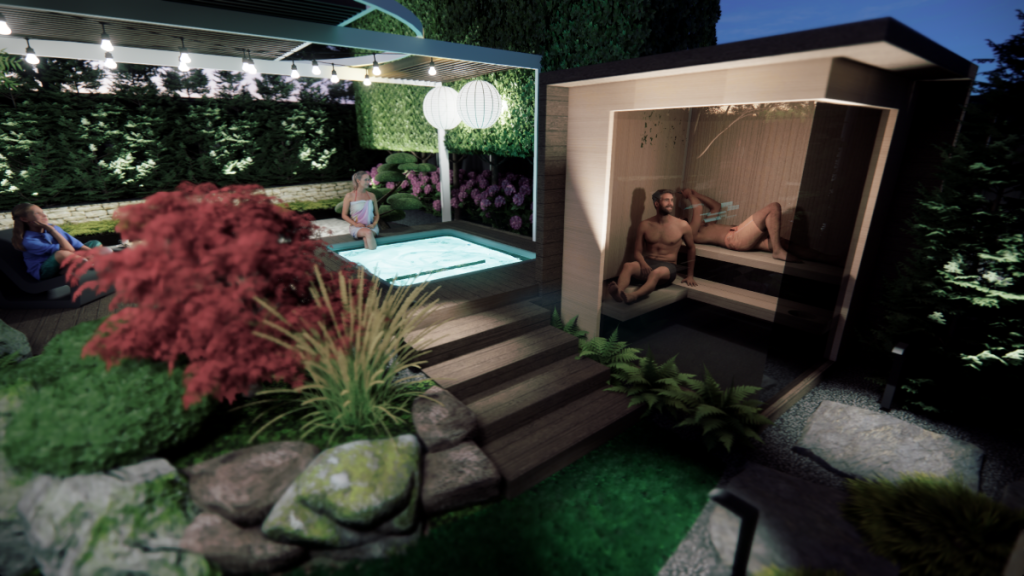The issue of health, wellness and self-care has been on the collective radar globally for several years now, and the industry has been getting out the word that its products perfectly align with this human need. More builders are seeing the results, as homeowners get the message.
“That’s a huge trend that just in the last year or two has become a major focus with almost every client I’m working with now, whether that’s been influenced by their time at a resort spa or a local spa,” says Randy Angell, CEO of Randy Angell Designs in Plano, Texas. “Then there’s the influence of home fitness over the last few years, where a lot of people have moved their fitness into the house as opposed to going to a gym or facility.”
Consumers want to bring the spa experience into their own homes. This translates not only in the rising popularity of such products as spas, saunas and, now, cold plunges. It also means they’re willing to set aside more square footage and budget to weave these products into a beautiful space that offers a transformative experience.

Randy Angell Designs
More homeowners are seeking separate health and wellness spaces. Walls or landscaping can be used to create specific zones, or they can be moved to side yards and other remote locations.
From spa to home
When it comes to specific wellness-related features, requests for cold plunges are significantly on the rise. Designer and builder Nick Hauk estimates that about 60% of his new clients ask about them. Out of that, he says, 30% to 40% of them move forward with adding the feature.
“We’re seeing a lot of architects who spec it into their homes as well,” he observes. “So they’re in the front end of a project.”
He also reports seeing an uptick in inquiries about wooden barrel saunas.
When a client moves forward with a cold plunge, he’ll typically install a stainless-steel model, finding them more efficient and cost-effective than building one out of concrete, especially indoors. As far as location, his clients most commonly request them to be placed inside the home, near the master bedroom or gym.
“Most people don’t want to walk very far from their master bath to the cold plunge and go back inside,” he explains.

Randy Angell Designs
The total experience
But it’s not always as simple as selling more wellness-related features and incorporating them into the backyard design.
Angell sees more of his clients asking for dedicated wellness spaces with spas, cold plunges, or other therapeutic features set aside to create a serene area, removed from the more active recreational, play and entertainment destinations.
“We’re seeing a lot of requests for outdoor showers and installing a [fiberglass or acrylic] spa as opposed to the spa in the pool,” Angell says. “We’re creating whole wellness areas in our backyards. That’s certainly something that just in the last couple years has gained a lot of traction.”
These wellness areas may include yoga spaces as well. But it’s not just about the activities themselves. Designers are expected to create an aesthetic to match. For his clients, that often means a Zen-influenced space.
“They’re wanting to create a space within the yard that is kind of an escape, Angell says. “Oftentimes it means bringing in natural elements, like using wood or composite wood decking, shade structures, and small recirculating waterfeatures.”
Gentle, calming waterfeatures, such as spheres with water cascading over them, often make a perfect fit, he adds. “It is recreating an experience they had at a really luxurious spa.”
Creating these spaces outdoors could involve adding some type of divider, whether it be a wall or landscaping – or making use of a narrow or secluded side yard.
“Separate it out as its own zone so that it really has a more intimate feel, as opposed to having just a sauna and cold plunge next to the pool in the backyard,” Angell advises. “Part of what makes it magical is getting that scale down to human size… where you feel that peace and enclosure. Even though you see the sky, you want to feel like it’s a more intimate space.”

